We were sickened to learn of yet another mass terrorist attack – this time at Turkey’s Ataturk Airport in Istanbul. It took us back five years to when we visited Turkey, the land where East met West at the Straits of Bosphorus on the Silk Road.
We were in Turkey in May 2011 when the U.S. took out Osama bin Laden. (More about that experience in my next blog.) It was also the month civil war broke out in neighboring Syria. The Turks, who since 1923 have had a secular parliamentary government, felt the unrest in Syria, under the rule of the Ba’ath Party with the al-Assad regime, would be quickly crushed.
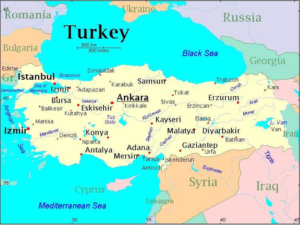 The Arab Spring began in 2010 with joy and social media buzz – the year before we went to Turkey. Shortly after our trip, those early joyous calls for greater democracy in Arab League countries turned to dismay. By 2014, upheaval had led to bloodshed as the Islamic State gained control over territory in Syria and Iraq. Today refugees by the millions flee war-torn countries and the world grapples with forced migration.
The Arab Spring began in 2010 with joy and social media buzz – the year before we went to Turkey. Shortly after our trip, those early joyous calls for greater democracy in Arab League countries turned to dismay. By 2014, upheaval had led to bloodshed as the Islamic State gained control over territory in Syria and Iraq. Today refugees by the millions flee war-torn countries and the world grapples with forced migration.
When we visited Turkey, this tragic scenario was unforeseen. We spend three days in Istanbul, then traveled to an enchanting area known as Cappadocia before driving south to the beautiful coastal resort town of Antalya. Our trip took us on a two-masted wooden sailing ship called a gulet for three nights. It was most appropriate for visiting Turkey’s Turquoise Coast, a wedding present to Cleopatra from Mark Anthony. Our final destination was the ancient town of Ephesus on the Aegean Sea.
We went to Turkey on a small group tour organized by Overseas Adventure Travel (OAT). The trip began at the same airport where the recent tragedy occurred. Turkey and was our first experience in a country where Islam is the major religion with the call to prayer ringing out five times a day.
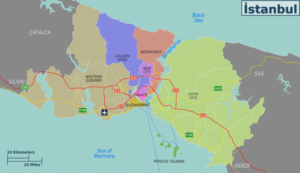 We stayed at a small hotel on the edge Istanbul’ Old City, a walled area basically Constantinople in days of old. While we took buses to major tourist sites, we could have walked to many of them. One outing was by boat, a cruise on the Bosphorus, the world’s narrowest, natural strait. This busy passage is used for international navigation that divides Istanbul into two sides: one is European and the other Asian. As the continental border between Europe and Asia, the Bosphorus connects the Black Sea with the Sea of Marmara — and by extension via the Dardanelles, to the Aegean Sea and the Mediterranean.
We stayed at a small hotel on the edge Istanbul’ Old City, a walled area basically Constantinople in days of old. While we took buses to major tourist sites, we could have walked to many of them. One outing was by boat, a cruise on the Bosphorus, the world’s narrowest, natural strait. This busy passage is used for international navigation that divides Istanbul into two sides: one is European and the other Asian. As the continental border between Europe and Asia, the Bosphorus connects the Black Sea with the Sea of Marmara — and by extension via the Dardanelles, to the Aegean Sea and the Mediterranean.
A must see is Istanbul’s Grand Bazaar Market, truly grand in scale and a place one could easily get lost, as I did, several times.

The Spice Bazaar Market*
It’s one of the largest and oldest covered markets in the world with 61 covered streets and over 4,000 shops. Personally, I found the Spice Bazaar more to my liking with only 85 shops selling mounds of spices in every color and description, Turkish delights, other sweets, dried fruits and nuts, plus a smattering of jewelry and souvenir shops sprinkled in.
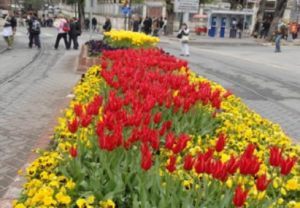
Tulips were in their full radiant bloom
A surprise on our arrival was the many gorgeous tulips. We were told tulips are Turkey’s national flower.
Native to Turkey, tulips were exported to Holland!
Must on any tourists’ itinerary is Istanbul’s big three sites: the Hagia Sofia, the Blue Mosque and the Topkapi Palace, all located in the Old City.
Completed in 537 AD, the Hagia Sofia is a structural marvel with its massive dome. Modern engineers continue to study this dome to learn how it has survived earthquakes and the ravages of time.
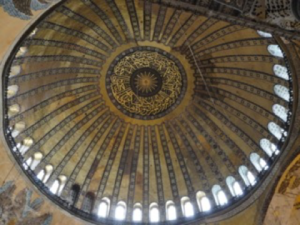
Huge Dome of the Hagia Sofia
Built as a Greek Orthodox cathedral, the Hagia Sofia was the seat of the Patriarch of Constantinople. During the Fourth Crusades in the early 13th century, Constantinople was overran and the Hagia Sofia became a Roman Catholic cathedral. When the Turks conquered the city in 1453, the Hagia Sofia was converted to a mosque which it remained until 1935. The founder of the Republic of Turkey and its first president, Mustafa Kemal Atatürk, transformed the Hagia Sofia into a museum.
The Sultan Ahmed Mosque, or Blue Mosque as it is better known, was built in the early 1600’s. The magnificent primarily hand-painted blue tiles adorn the mosque’s interior walls, thus the name Blue Mosque.

Blue Mosque is beautifully lit at night
At night the mosque is bathed in lights framing the five main domes, six minarets and eight secondary domes. When we visited, men were coming in for mid-day prayer. As we watched, they quietly walked to the front of the massive prayer hall, kneeled on the lush red carpet and prayed.
The Topkapi Palace was the home of Ottoman Empire sultans from the 15th century to the 19th century. Overlooking the Bosphorus, the palace is safely cloistered behind high thick walls with watch towers. It is a vast complex with spectacular Islamic art and intricate hand-painted tilework linking courtyards with beautiful decorative rooms.
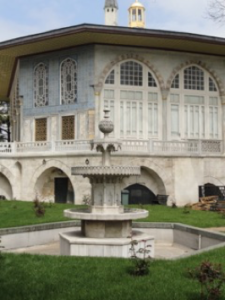
Topkapi Palace grounds
The palace included the Imperial Council Chamber with adjacent private rooms and special one-way viewing for the sultan’s private use as well as rooms for the sultan’s large harem. It also housed the Imperial Treasury with its dazzling gold objects and many precious jewels.
Upon leaving Istanbul, we flew to Kayseri in central Anatolia and were met by a chartered van for the rest of trip to Turkey’s coast. Our first stop in Cappadocia was Goreme National Park, a World Heritage site, well known for its unique geological landscape. Called fairy chimneys, they are large cone-shaped rocks formed when ancient volcanoes left thick ash which hardened into soft rock. Over time, wind and rain eroded these massive rocks leaving fairy tale vistas of cones, pillars, mushrooms and chimneys.
Ancient cultures living in Cappadocia left their mark as well. Digging into the soft rocks, these ancient people built dwellings, castles, worship areas, storehouses and even stables for animals.
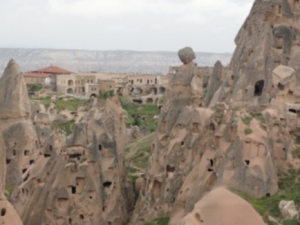
Cappadocia – a land of fairy chimneys
This large area is now a vast network of tunnels built in honeycombs forming entire towns, some with as many as eight levels going underground.
With erosion once again threatening Cappadocia, preservation efforts were underway when we were there in 2011. The increased tourism meant more modern development including hotels and restaurants built into the rock.
With the current unrest in the Middle East, I fear what has become of the growing tourist trade, the thriving pottery and rug- making cottage industries and the enjoyable people we met while visiting Cappadocia.
In my next blog, I will discuss watching a master potter at work, visiting a rug-making factory, seeing the famous Whirling Dervishes, meeting a sensitive Iman on the day bin Laden was killed, visiting Turkey’s beautiful coastal resort and touring the Turquoise Coast on a lovely wooden boat, a gulet.
*Photos by Marcia Seifert
The Takeaway: Going to Turkey was an amazing adventure from visiting a land of the Islamic faith as it is intended to be, one that preaches peace and kindness, to ancient sites that bear witness to a highly-developed civilization thousands of years old. What interesting adventures have you had while traveling to a foreign land? Share and let’s learn from each other. Include your name and email address or phone number so I may contact you if I have a question. I will not publish your name. Contact me at [email protected]
